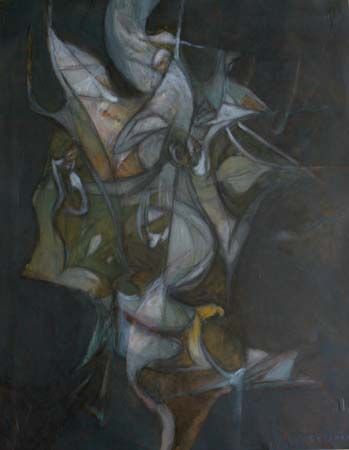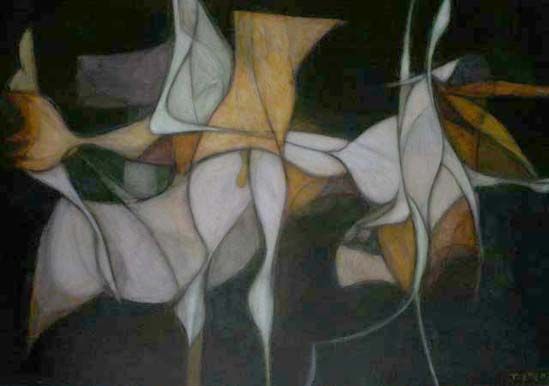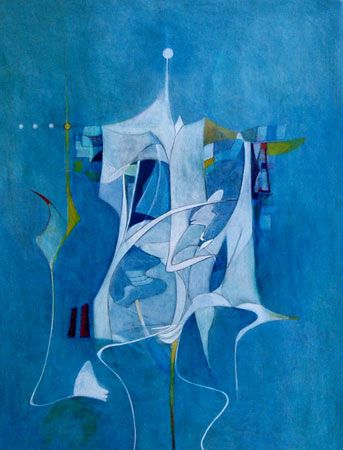/ A World That Stands Alone / Muheb Esmat
A World That Stands Alone
Muheb Esmat
In Tamim Etemadi’s paintings, abstraction is not a retreat from the world but a deliberate method of engaging with its tensions, silences, and rhythms. Across works such as Journey, Intimacy, and Dona Seduta, he builds compositions that rely not on narrative or representation, but on the dynamic interplay of line, shape, and space. His paintings operate as systems of movement, carefully calibrated structures where tension and balance, openness and compression, are orchestrated through formal relationships alone.
In 1963, a critic for The Kabul Times wrote of Etemadi’s paintings: “Looking at Tamim Etemadi’s paintings one is gently ushered into a quiet, simple and lonely world. There is no physical contact in this world, everything stands alone, separate, divorced. Space is cramped and time everlasting.” The review, published when Etemadi was still based in Kabul, points to his early engagement with abstraction, a visual language already marked by spatial tension, emotional quiet, and a deliberate sense of remove. What the critic described as loneliness and timelessness now feels, in hindsight, like the beginning of a lifelong investigation into form, atmosphere, and the poetics of distance.
Born in 1942 in Kabul, Etemadi completed his education at Habibia High School before moving to Italy in 1965 to study at the Academy of Fine Arts in Rome. By that time, his commitment to abstraction was already evident. Looking at the evolution of his work, it seems clear to me that his years in Europe were not a reinvention but a period of refinement. The exposure to formal training and his proximity to a wide circle of artists offered an important space for development. His visual vocabulary, while always deeply personal, became more structurally assured and expansive during this period. When he returned to Afghanistan in 1974 to teach at the newly established Faculty of Fine Arts at Kabul University, he brought back not only a mature sensibility but also a way of seeing shaped by both distance and continuity with his early practice.

Journey, acrylic on paper. Courtesy of the artist’s website, tamimetemadi.com. (Dimensions and date unknown.)
In Journey, an acrylic on paper painting, Etemadi constructs a dense, vertically oriented composition where sharp contours and overlapping, angular shapes seem to twist and fold inward. The palette is dark and muted, rich with grays, greens, ochres, and occasional flashes of violet. The forms are tightly packed, their interaction creating a sense of internal pressure and contraction. The visual energy here is one of compression; the eye moves through a labyrinth of contours that imply movement under constraint. This controlled intensity reflects a compositional interest in how forms can activate space not through expansiveness but through depth and enclosure. The painting has a deeply gut-wrenching feel to it.

Intimacy, mixed media on canvas. Courtesy of the artist’s website, tamimetemadi.com. (Dimensions and date unknown.)
By contrast, Intimacy, mixed media on canvas, unfolds more horizontally. Here, the forms, though similarly elongated and sinuous, move across the canvas with more room to breathe. The color palette is softer: whites, yellows, and pale greens blend with hints of amber and shadow. The contours are smooth, the transitions between figure and ground more gradual. Yet the painting remains spatially tense, built on the careful adjacency of curving forms that touch, pull away, or overlap without fully merging. Etemadi’s concern here seems to be the modulation of proximity. He explores how to suggest connection or separation using formal means alone. The composition relies on balance between figure and void, color and line, unity and fragmentation.

Dona Seduta, acrylic on board. Courtesy of the artist’s website, tamimetemadi.com. (Dimensions and date unknown.)
Dona Seduta, acrylic on board, shifts the register yet again, this time into a luminous, vertical composition dominated by a radiant field of blues. The abstracted central form suggests a seated figure, but what captivates most is the painting’s lightness and sense of upward motion. Unlike the denser compositions of the previous works, Dona Seduta offers clarity and openness. Thin, fluid lines and translucent shapes float across the canvas, anchored by geometric accents such as rectangles and dots that provide rhythm and spatial structure. Etemadi achieves a remarkable balance between movement and stillness, using a cool, unified palette to suspend his forms in an atmosphere that feels at once grounded and ethereal. The vertical thrust of the central lines, capped by a single dot, suggests ascension or clarity, giving the form a respectfully imposing presence.
Taken together, these paintings reflect not improvisation but precision. They offer a choreography of form in which each element plays a structural role. Etemadi’s line is never decorative; it defines spatial tension, suggests motion, and carves out emotional resonance. His use of color, too, is never arbitrary. It builds atmosphere, distributes weight, and shifts the psychological tone of the composition. What emerges is a body of work that reveals its strength quietly through careful composition, thoughtful restraint, and a deep commitment to visual language. Over more than half a century of work, Etemadi has cultivated an abstract practice that feels both deeply personal and rigorously composed, offering viewers a world of measured intensity and enduring complexity. What might once have been read as a “lonely world,” in the words of the early critic, now reveals itself as a field of precise attention, a place where every form and every interval is calibrated to speak in silence.